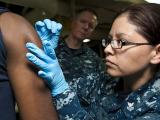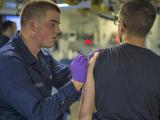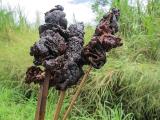Jul 17, 2003 (CIDRAP News) People vaccinated for smallpox in the distant past can be successfully revaccinated with diluted vaccine and have fewer side effects than people receiving the vaccine for the first time, according to a randomized, single-blind study reported by Sharon E. Frey, MD, and colleagues in the Jun 25 Journal of the American Medical Association.
Study participants included 80 subjects aged 32 to 60 years who had been vaccinated against smallpox before 1971 (non-naive group) and 10 vaccinia-naive subjects aged 18 to 31 years. Non-naive subjects were randomized to receive undiluted vaccine or vaccine diluted to one of three concentrations (1:3.2, 1:10, or 1:32). The vaccine, Dryvax, was from the remaining stock used during the smallpox eradication campaign. Vaccination was given in the deltoid region of the arm using bifurcated needles and making 15 skin punctures. The vaccination site was covered with gauze and a semipermeable adhesive dressing that was changed every 3 to 5 days until sufficient scabbing had occurred.
The major end point used to determine vaccination success was the occurrence of a major reaction, defined as formation of a vesicular or pustular lesion or of an area of definite, palpable induration or congestion around a central lesion (crust or ulcer) 6 to 8 days after vaccination. Also studied to determine success were viral shedding and antibody responses.
Among non-naive subjects, 64 of 80 showed major reactions after initial vaccination19 of 20 (95%; 95% confidence interval [CI] 75-100) in the group receiving undiluted vaccine and 18 of 20 (90%; 95% CI 68-99), 17 of 21 (81%; 95% CI 58-95), and 10 of 19 (52.6%; 95% CI 29-76) receiving the 1:3.2, 1:10, and 1:32 dilutions, respectively. All 10 of the vaccinia-naive subjects showed major reactions.
A comparison of groups showed that the non-naive subjects had significantly smaller lesions than the vaccinia-naive subjects (P=.04). In addition, the incidence of fever after successful vaccination was significantly less in the non-naive group (6 of 64, compared with 6 of 10; P=.02).
Vaccinia virus was recovered from swab samples in 60 of the 64 successfully vaccinated non-naive subjects and in all 10 of the vaccinia-naive subjects on at least one occasion. Viral shedding from the vaccination site lasted 2 to 6 days longer in the vaccinia-naive group than the non-naive group, and peak mean titers were significantly higher in the former group (P=.002).
Antibody response was determined by performing modified neutralization assay and IgG enzyme-linked immunosorbent assay on prevaccination samples and on samples collected at several intervals after vaccination. Of the 80 non-naive subjects, 76 had preexisting antibody; none of the vaccinia-naive subjects did. The non-naive group had significantly higher and more rapid antibody responses than the vaccinia-naive group (P=.002 at day 28, P=.003 at 6 months). The authors state that the antibody response patterns in the non-naive subjects as well as the milder clinical events after vaccination in this group "supports the hypothesis that B cell memory is long-lived after smallpox vaccination."
Frey SE, Newman FK, Yan L, et al. Response to smallpox vaccine in persons immunized in the distant past. JAMA 2003 Jun 25;289(24):3295-9


















